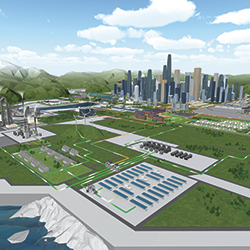Distribution networks hold the key to the UK’s energy future
Peter Jones, ABB Technology Strategy Manager, says flexible distribution networks are increasingly vital as the UK shifts towards decentralised and renewable generation.

This year’s Future Energy Scenarios document, recently published by National Grid, provides an intriguing insight into the UK’s current energy revolution. It outlines four possible scenarios, according to predicted levels of prosperity and green ambition: ‘Two Degrees’, ‘Slow Progression’, ‘Steady State’ and ‘Consumer Power’ (Figure 1). But whatever the eventual outcome, there appears to be a shift towards decentralised and renewable generation. The only difference is the pace and extent of this change.
The inevitable result of this shift will be a profound change in the roles played by transmission and distribution networks, because the bulk of solar energy and other decentralised resources will be connected at the distribution level. While in the past the main focus has been on developing transmission networks capable of working hard in winter and less so in summer, under some of the future scenarios outlined by National Grid transmission demand is set to steadily fall in winter. And it could virtually disappear in summer at certain times of the day according to the other scenarios. In fact, this trend has already started. On 25 March this year, for the very first time, the electricity demand on the transmission network was lower during the afternoon than it was overnight due to the high level of solar generation.
Ready for the 2026 eclipse
In contrast, distribution networks now need to be flexible to deal with complex, intermittent power flows. A particularly interesting example of the challenge they will face is highlighted in National Grid’s pre-planning for the UK’s next solar eclipse on 12 August 2026. By then the UK could, under one of the scenarios, have up to 26GW of solar power, over twice the 12GW we have today. When the shadow falls at 19:10 there could be a solar generation deficit of around 3.5GW for 30 minutes.
Technology boosts flexibility
A raft of technologies will help provide distribution grids with the required flexibility, including demand response mechanisms. Storage will also play an important role, with up to 10.7GW installed by 2050 under one scenario, including a substantial number of battery energy storage systems (BESS).
These could be critical in helping the UK’s power networks maintain a stable grid frequency. Unlike traditional generation plant, renewable energy does not typically offer the spinning mass – generally turbines and generators at the production end of the network – which creates the inertia (resistance to change in motion) to help limit frequency fluctuations when a power imbalance occurs.
The strategic deployment of a BESS can help bridge this growing inertia gap by delivering vital grid frequency support, absorbing power when the frequency is too high and injecting power when the frequency is too low. Other BESS functions include load levelling, peak power shaving and power smoothing.
We are finding that network operators are increasingly reluctant to commit to major investments in new infrastructure. Instead, they are more interested in seeking new approaches to get the most out of their existing networks. One example of a technology that has great potential in this area is the Flexible Power Link, which is a back-to-back (AC-DC-AC) converter. It controls and transfers power between two previously incompatible distribution grids and allows the operator to balance generation and demand more effectively.
Another interesting technology is the Line Voltage Regulator (LVR). Traditional distribution networks were designed on the basis of a voltage drop along the line from substation to the consumer. However, the introduction of distributed generation means that grids can experience voltage rises. If supply exceeds demand, there is potential for the voltage to exceed the statutory limits. In this case, the operator must curtail generation to maintain stability or even invest in a new connection. Instead, the LVR can effectively ‘recalibrate’ the voltage to maintain it in the allowed range.
New thinking required
Overall, accommodating renewables might require a complete rethink of winter and summer network operations. Possibly operating as a solid, interconnected network in winter and changing to a more regional operation in summer – perhaps made up of a large number of smaller-scale microgrids (Figure 2).

There are some particular areas in which network design standards can help make a successful transition. More distributed energy resources in the form of renewables and other sources, such as combined heat and power, embedded in the distribution network can, by themselves, improve network security and resilience if planned and coordinated to operate together. By carefully modelling the operation of these embedded resources within existing and new distribution networks, large network cost savings could be realised and quantified.
Furthermore, it would be helpful to look at the overall energy challenge. Not only focusing on electricity but also considering the role that gas and heat will play in handling peak demand to cope with intermittency well into the future. One way this can be achieved is that, as distribution network operators transition to distribution system operators, they could develop and publicise regional energy strategies. This will provide an overarching vision for the energy future of communities and industrial customers within a region and allow much closer customer involvement in planning for a clean and cost-effective energy future.
By Peter Jones, Technology Strategy Manager, ABB






Follow us
Advertise
Free e-Newsletter